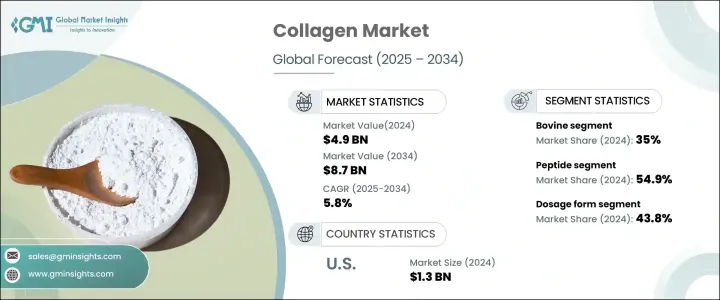PUBLISHER: Global Market Insights Inc. | PRODUCT CODE: 1698545

PUBLISHER: Global Market Insights Inc. | PRODUCT CODE: 1698545
Collagen Market Opportunity, Growth Drivers, Industry Trend Analysis, and Forecast 2025-2034
The Global Collagen Market was valued at USD 4.9 billion in 2024 and is projected to expand at a 5.8% CAGR from 2025 to 2034. Market growth is driven by increasing demand for collagen-based supplements and their rising incorporation in food and beverages. Collagen supplements, available in powders, pills, and functional foods, are gaining popularity due to their high absorption rates. The human body produces collagen, a vital protein for skin, bones, joints, and muscles, but its production declines with age, leading to issues like wrinkles and joint discomfort.

Supplementing with collagen has been found to improve skin hydration and elasticity, reducing visible signs of aging. With the global aging population rising, demand for health and wellness supplements, including collagen, is expected to grow significantly. Consumers are increasingly focused on personal health, appearance, and preventive care, further fueling the market. Additionally, collagen is widely used in the food and beverage sector to enhance texture, elasticity, and stability in various products. However, challenges remain, particularly regarding the taste and aroma of marine collagen, which require masking techniques when used in formulations.
| Market Scope | |
|---|---|
| Start Year | 2024 |
| Forecast Year | 2025-2034 |
| Start Value | |
Table of Contents
Chapter 1 Methodology & Scope
- 1.1 Market scope & definition
- 1.2 Base estimates & calculations
- 1.3 Forecast calculation
- 1.4 Data sources
- 1.4.1 Primary
- 1.4.2 Secondary
- 1.4.2.1 Paid sources
- 1.4.2.2 Public sources
Chapter 2 Executive Summary
Chapter 3 Industry Insights
Chapter 4 Competitive Landscape, 2024
Chapter 5 Market Size and Forecast, By Product, 2021-2034 (USD Billion) (Kilo Tons)
Chapter 6 Market Size and Forecast, By Source, 2021-2034 (USD Billion) (Kilo Tons)
Chapter 7 Market Size and Forecast, By Dosage Form, 2021-2034 (USD Billion) (Kilo Tons)
Chapter 8 Market Size and Forecast, By Application, 2021-2034 (USD Billion) (Kilo Tons)
Chapter 9 Market Size and Forecast, By Region, 2021-2034 (USD Billion) (Kilo Tons)
Chapter 10 Company Profiles




